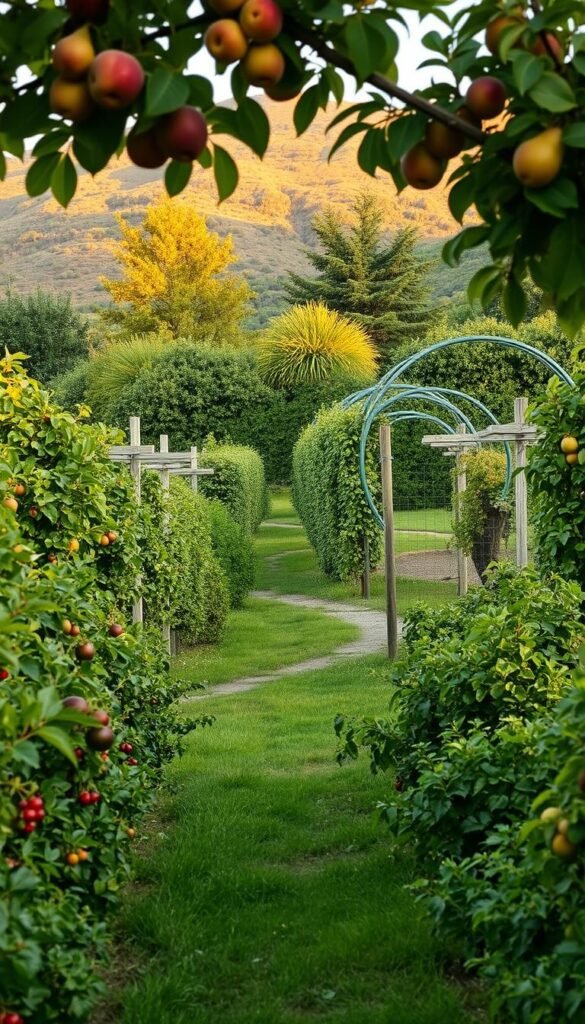Imagine turning your yard into a productive fruit-growing space that keeps your kitchen stocked for months. With smart planning, even a modest area can deliver bushels of fresh peaches, plums, or citrus. A single mature lemon tree produces over 200 pounds of fruit annually—enough to share with neighbors or preserve for year-round use.
Successful growing starts with understanding how different varieties work together. Early-bearing berries might kick off your season, while late-fall apples extend the bounty. Proper spacing ensures each plant gets enough sunlight and airflow, preventing disease while maximizing yields.
You don’t need acres to enjoy homegrown goodness. A 15×15-foot plot can host six dwarf trees when arranged thoughtfully. Modern backyard setups focus on diversity over quantity, letting you enjoy staggered harvests instead of overwhelming gluts.
Strategic planning today means biting into sun-warmed apricots next summer and pressing cider every autumn for decades. Unlike store-bought options, your homegrown harvests will ripen fully on the branch, packing unmatched flavor into every bite.
Understanding Your Orchard’s Unique Needs
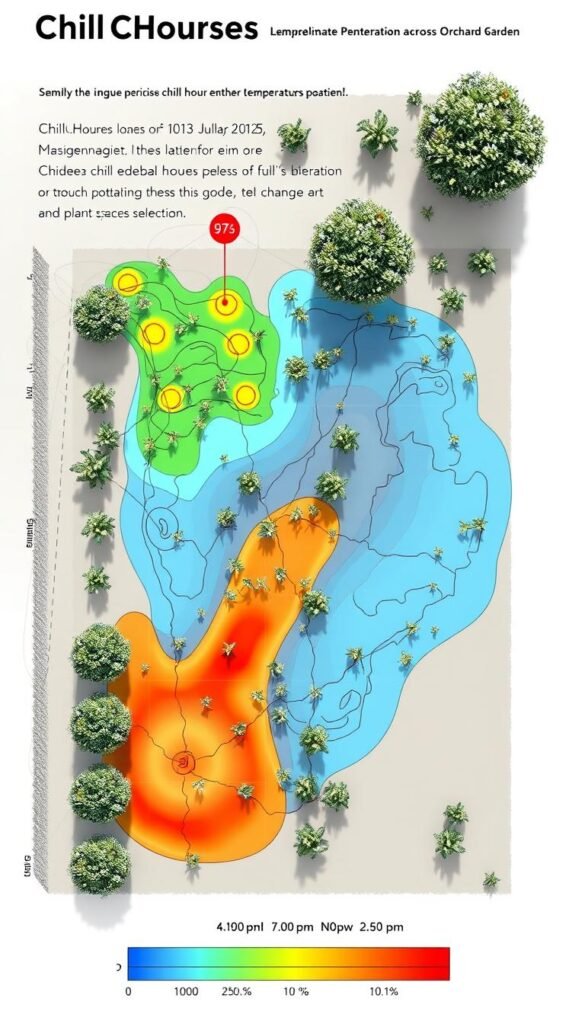
Your backyard’s success with fruit trees depends on three non-negotiable factors: cold requirements, daily light patterns, and earth composition. Get these right, and you’ll avoid years of stunted growth or barren branches.
Cold Requirements Decoded
Chill hours dictate whether your chosen varieties will flower or fail. These cold periods (32°F-45°F) trigger dormancy breaks—without them, trees like apples or cherries won’t set buds properly. Warm-climate growers often make the mistake of planting high-chill pears when low-chill figs would thrive.
Your local extension office provides precise climate data, while tools like Purdue University’s interactive map show regional averages. Southern growers might select peaches needing 400 chill hours, while Pacific Northwest gardeners could opt for 900-hour cherry types.
Sun and Earth Essentials
Track sunlight across seasons—fruit trees demand 6-8 hours daily. Morning sun dries dew quickly, reducing fungal risks. Test soil pH and nutrients using kits from farm stores; most varieties prefer slightly acidic earth (6.0-6.5).
Dig test holes after storms to check drainage. Roots rotting in soggy soil kill more trees than pests do. Amend clay-heavy areas with compost to create the loose, breathable ground your plants crave.
Designing an Effective Orchard Garden Layout
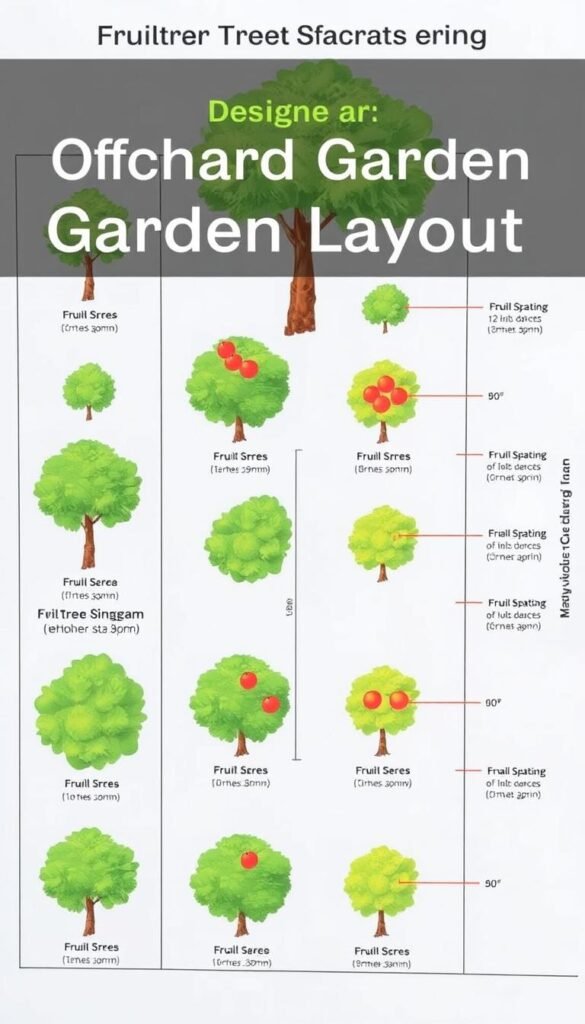
Creating a thriving fruit haven begins with smart spatial planning. Grab graph paper and colored pencils to sketch your available area—this visual roadmap helps avoid costly mistakes later.
Paper Plans for Real-World Success
Measure every corner before drawing your first tree symbol. Note where shadows fall at different times and mark water access points. Small space growers often discover unexpected sunny patches perfect for dwarf varieties.
Smart Spacing Strategies
Here’s the golden rule: match tree size to available space. Standard types need 20 feet width, semi-dwarfs 12-15 feet, while compact varieties thrive in 10 feet. Modern techniques let you squeeze trees 5-8 feet apart—or even 4 feet with annual pruning.
Why crowd plants? Tight planting naturally limits growth while extending your harvest window. Four trees in one traditional space means fresh fruit for 12 weeks instead of three. Neighboring roots create friendly competition that keeps canopies manageable.
Creative Growing Solutions
Turn limitations into advantages with these ideas:
- Train trees flat against fences (espalier style)
- Combine multiple varieties in one wide hole
- Create edible hedges with columnar apples
Walk your planned layout before digging. Can you reach every branch for pruning? Does morning sun hit the lemon trees? Adjust your paper plan until it solves real-world challenges.
Orchard Garden Layout: Managing Spacing, Harvest Times, and Varied Species
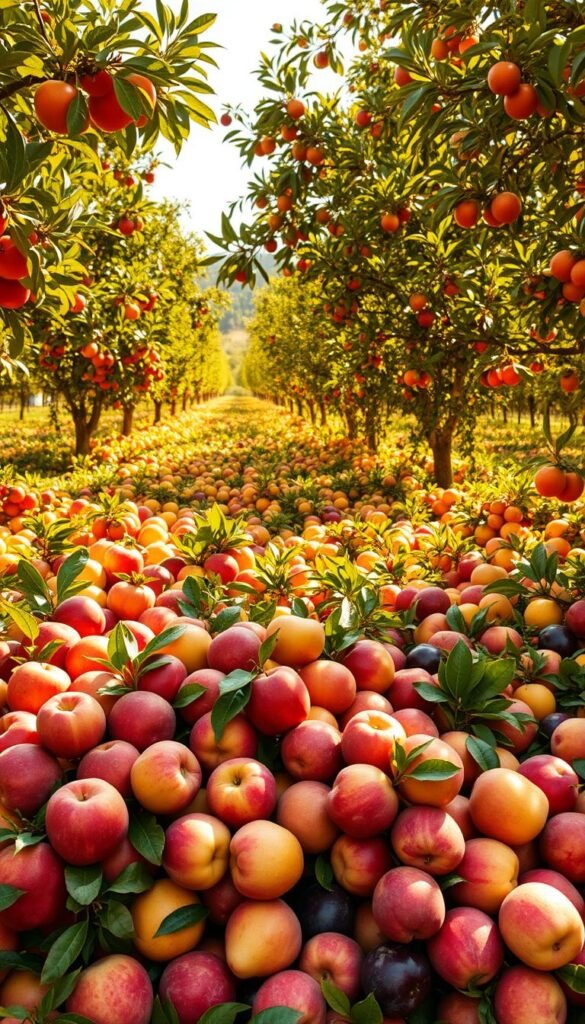
Transform your growing area into a year-round snack bar by mixing fruits that mature at different paces. Smart selection lets you enjoy fresh flavors from June’s first berries to October’s crisp apples without overwhelming your countertops.
Integrating Varied Fruit Species for Extended Yields
Pick three types of each favorite fruit: early, midseason, and late. A combo like Stella cherries (June), Lapins (July), and Sweetheart (August) stretches your cherry season to 10 weeks. Pair these with August peaches and September persimmons for nonstop sweetness.
| Fruit | Early Season | Midseason | Late Season |
|---|---|---|---|
| Apples | Ginger Gold | Honeycrisp | Arkansas Black |
| Plums | Methley | Santa Rosa | Shiro |
| Pears | Bartlett | Comice | Winter Nellis |
Balance fresh-eating stars like Suncrest peaches with preserving champs like Italian prune plums. Group plants by care needs—acid lovers (blueberries) together, drought-tolerant figs elsewhere. This approach simplifies maintenance while keeping your harvest basket full.
Check local bloom charts to avoid pollination gaps. Some varieties need specific partners—a Fuji apple won’t fruit without a Gala nearby. Your county extension office offers free planting guides tailored to your area’s frost dates and pest pressures.
Selecting the Right Fruit Tree Varieties
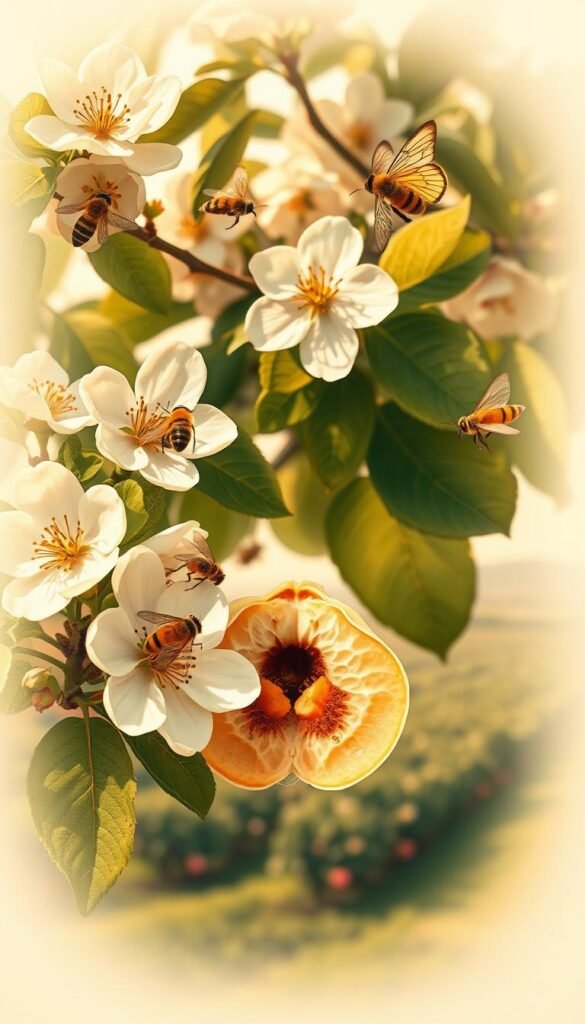
Your fruit-growing success hinges on choosing trees that match both your taste buds and local growing conditions. Let’s explore how pollination needs and regional adaptability shape your selection process.
Self-Fertile vs. Cross-Pollination Needs
Self-fertile varieties simplify backyard growing. Apricots, figs, and peaches set fruit without partners—ideal when space is tight. European plums like ‘Stanley’ will even pollinate nearby Japanese plums!
| Self-Fertile | Needs Partner | Pollination Range |
|---|---|---|
| Apricots | Apples | 50 feet |
| Citrus | Pears | |
| Peaches | Cherries | Same bloom period |
Cross-pollinators like apples need compatible neighbors. A ‘Honeycrisp’ apple requires a ‘Fuji’ or ‘Gala’ blooming simultaneously within 50 feet. Urban growers can often use neighborhood trees as partners—just confirm bloom overlap.
Choosing Climate-Adapted Cultivars
Zone ratings aren’t suggestions—they’re survival guides. While ‘Granny Smith’ apples thrive in Vermont (zone 4), Floridians should choose low-chill ‘Anna’ types. Consider these regional favorites:
| Fruit | Cold Zones | Warm Zones |
|---|---|---|
| Apples | 3-5: Haralson | 6-8: Dorsett Golden |
| Pears | 4-6: Bartlett | 7-8: Hood |
| Cherries | 4-6: Montmorency | 7-9: Minnie Royal |
Local nurseries stock varieties proven in your area. Ask about disease-resistant options like ‘Liberty’ apples or ‘Olympic Giant’ figs. Pair this knowledge with your family’s favorite flavors for a personalized harvest.
Preparing Your Soil and Watering Needs
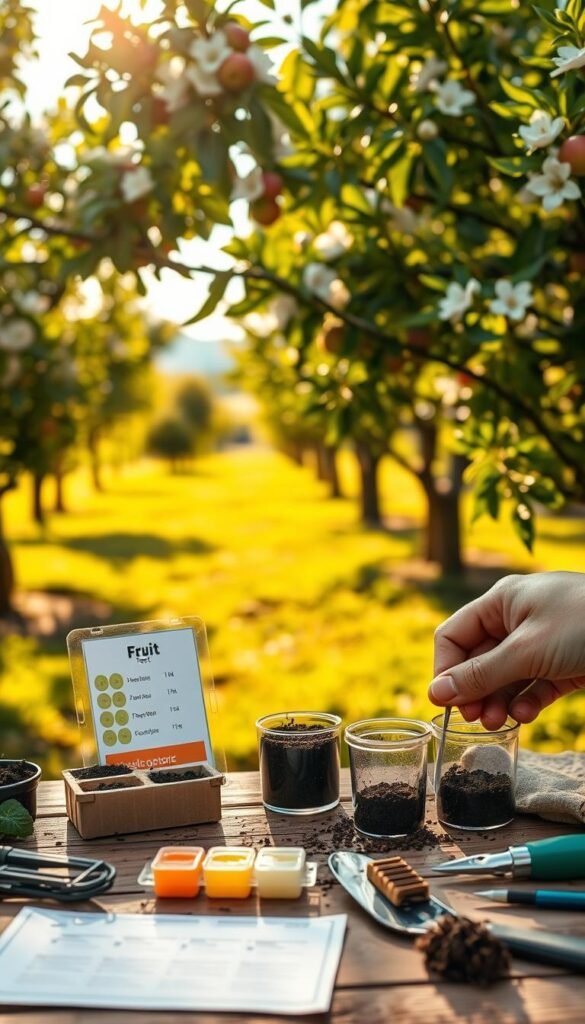
Healthy soil forms the foundation for thriving plants. Before digging your first hole, grab a soil test kit from your local extension office or farm store. These $10-$20 investments reveal exactly what your ground needs to support vigorous root growth.
Conducting Soil Tests and Amending Nutrients
Test results show pH levels and nutrient gaps. Most fruit trees prefer slightly acidic soil (6.0-6.5). If your ground tests alkaline, sulfur amendments can help. Clay-heavy areas benefit from compost to improve drainage.
Skip the temptation to fill planting holes with rich mixes. Trees develop stronger roots when they adapt to native soil. Instead, loosen the ground 3 feet wide around each hole. Top-dress with 2 inches of compost to feed surface roots.
Water access matters as much as soil quality. Young plants need weekly soaking during dry spells. Consider drip irrigation or seasonal watering adjustments for consistent moisture. Mature trees still require summer drinks in drought conditions.
- Test soil 6 months before planting
- Amend large areas, not just holes
- Install rain barrels near planting zones
Nursery experts recommend waiting 4 weeks after amending before planting. This lets nutrients integrate properly. Your patience pays off with trees that establish faster and bear fruit sooner.
Planning for Tree Pruning and Size Control
Keeping your trees productive and compact starts with smart pruning strategies. Unlike neglected specimens that become tangled and disease-prone, well-maintained plants reward you with easier harvests and healthier yields. Timing your cuts correctly—especially during active growth phases—makes all the difference in shaping strong, fruitful structures.
Summer Pruning Techniques to Manage Growth
Trimming during warmer months helps control size by slowing new growth. Focus on removing water sprouts and upright branches that block sunlight. For fruit trees, summer cuts after spring growth harden reduce vigor while directing energy to developing fruit.
Use sharp shears for clean cuts that heal quickly. Target 20-30% of new growth annually to maintain balance. This method works wonders for keeping dwarf varieties at picking height for years.
Maintaining a Manageable Canopy for Better Airflow
Open-centered shapes let breezes flow freely, reducing mold risks. Remove inward-growing branches each summer to create space between limbs. Aim for a vase-like structure where sunlight reaches every cluster.
Young plants benefit most from early training. Establish your tree’s framework in the first year by choosing 3-5 main branches. Annual touch-ups prevent overcrowding as the canopy matures. Pair this approach with high-density planting methods for maximum space efficiency.

